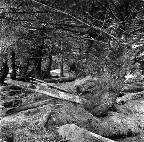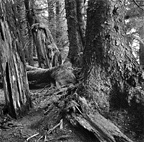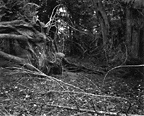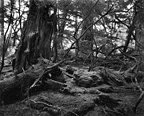
|
Captured
Beam
T'aanuu, Gwaii Haanas, June 13, 1999
|

|
Trees
in Transition
T'aanuu, Gwaii Haanas, June 13, 1999
|

|
Dying
Lower Branches
T'aanuu, Gwaii Haanas, June 13, 1999
|

|
Forest
Wall Opening
Swan Islets, Gwaii Haanas, June 14, 1999
|

|
Trunks
and Moss
Swan Islets, Gwaii Haanas, June 14, 1999
|

|
Fallen
Branches
Swan Islets, Gwaii Haanas, June 14, 1999
|

|
Moss-covered
Tree Fragments
Swan Islets, Gwaii Haanas, June 14, 1999
|
|
|
For further information about ABC Experiencing, please contact:
Karen Close keclose@yahoo.com
telephone: 705-835-5710 facsimile: 705-835-5726
*COPYRIGHT NOTIFICATION* All
contents of articles and images appearing anywhere on this website are
protected by International copyright law and may not be retrieved,
employed or redistributed in any form without written consent from the
artist.
************
click on any of the images to view an enlargement.
************
Pilgrimage
By Karen Close
Where is the
literature, which gives expression to Nature? He would be a poet who
could impress the winds and streams to his service, to speak for him;
who nailed words to their primitive senses... who derived his words as
often as he used them - transplanted them to his page with earth
adhering to their roots; whose words were so true and fresh and
natural that they would appear to expand like buds at the approach of
spring... from Walking by Henry David Thoreau
(1817-1862)
Although 1839 is attributed as the
dawn of photography and the daguerreotype practice flourished
throughout the1840's and 50's, in his lifetime Thoreau could not have
predicted that it would be the photographic image, not literature that
would capture Nature's true expression. From inception photographers
have sought lofty goals:
"My aspirations are to ennoble
photography ...by combining the real & Ideal and sacrificing
nothing of Truth by all possible devotion to Poetry and
beauty..." Julia Margaret Cameron
The Queen Charlotte Series recently
produced by Canadian photographer, Jeremy Taylor, resonates with
Thoreau's and Cameron's desires. This is a remarkable series;
beginning with the story of its birth, through the chronicle of its
process and anticipating its altruistic goals, the series fulfills the
most noble of fine arts' intents and speaks to those who believe art
can change the world. Taylor's eye saw one of Nature's mystical
paradises, Haida Gwaii, 'Place of Wonder', and recorded compositions
of wisdom and enduring strength. The detail his technical proficiency
brings to these images denotes master craftsmanship. During the year
2000 Taylor will market these images for the benefit of young 'at
risk' adolescents.
"I do photography because I
feel drawn to it. I love the process of doing my work. It almost
seems automatic for me to be making photographs." Jeremy
Taylor, August 27, 1999
As I contemplated writing this
article, I briefly discussed my impressions about the series and the
proposed content for this article, with Taylor. The above was his
response. Yet I persist in seeing a greater significance. Research of
his life, probing conversation, personal convictions and dreams reveal
the hand of destiny. In the late thirties Fred Taylor (Jeremy's
father) was motivated to paint images of socialist realism by a
dynamic woman active in the fledgling Canadian Communist Party. The
roots of the party ultimately withered when struck with the
realization that Marx's idealistic dreams for mankind were not the
true objective of Russia's Communist leaders. However, in the late
thirties, when Jeremy Taylor was a child absorbing his parents'
values, dreams were strong.
"Irene Kon took the time to
see the paintings offered Taylor and encouraged him to use his
'facilities, abilities and talents to help his fellow men'...
Irene's was a utopian dream that flew in the face of the evidence
around her, a tenacious belief that mankind was potentially warm,
cultured and beautiful...Irene, like Bethune, (Norman) believed in
universal happiness... 'We believed we could build a better world, a
world of co-operation, a world of people who would listen to one
another, and it was our love for one another that gave us such
energy... Irene and others talked to Fred about the importance of
art and the place it would have in the world after the revolution,
and he enjoyed both the feeling of belonging to something warm and
the concern for himself and his work. It was a welcome relief from
the old family constraints: coming down the stairs towards his
father on Sunday to be inspected for "church parade",
shoes shined, buttons perfect, terrified, as a friend recalled,
'that he wouldn't measure up to whatever it was that was expected of
a Taylor.' He was stimulated by the enthusiasm and talent of those
in the Artists' Group who were committed to producing socially
relevant work. He thought of himself not as an effete, isolated
romantic, but as "an art worker" with a definite function
and place in society". 1
When I first became acquainted with Jeremy Taylor's photographs I
felt the same draw that Irene Kon felt for his father's works. At that
time I had not heard the history, nor seen Fred Taylor's work. The
times and political climate have changed but the human need for
inspiration and for art to enlighten remain.
 continue reading our feature article. continue reading our feature article. |
